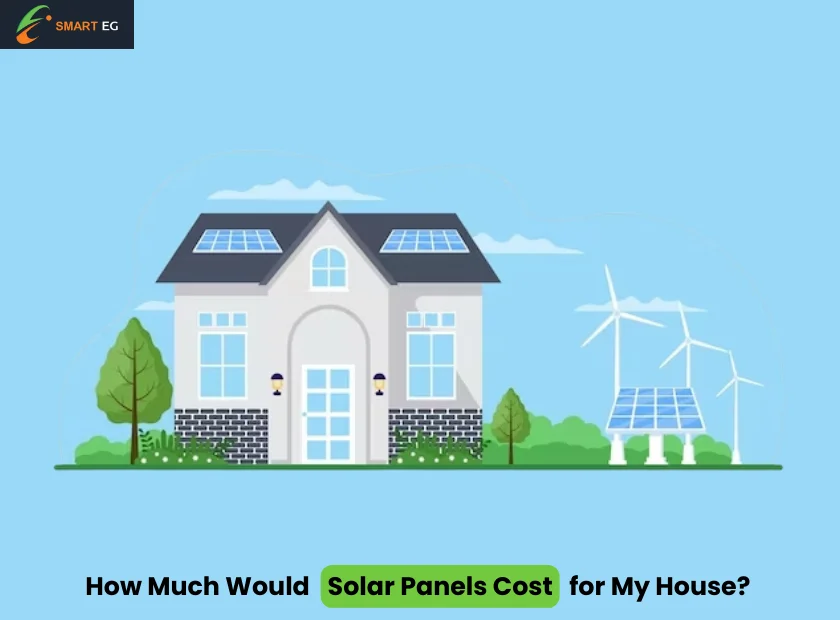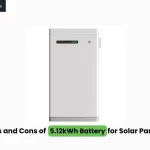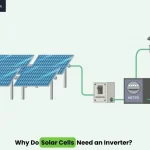How Much Would Solar Panels Cost for My House?

Residential solar panel use has increased dramatically in recent years, as environmentally concerned homeowners and forward-thinking communities seek sustainable energy choices. This increased interest arises not just from a desire to minimize carbon footprints, but also from a greater appreciation of the long-term economic benefits of solar energy.
Let us examine the multiple factors that determine the cost of solar panels, the decisions that homeowners should make, and the average solar panel for your home costs and ranges based on credible industry sources, to facilitate the quest for an affordable switch to solar energy.
Energy Consumption of Average Household
The first order of the business to figure out the average energy use of a household. According to the most recent data, the average US home uses roughly 10,500 kilowatt-hours (kWh) of power per year, which equates to approximately 880 kWh each month. This baseline serves as a benchmark against which to monitor your energy use.
There are a lot of factors that influence the overall energy requirement:
- Home Size: Larger homes often need more energy to power various appliances and systems. The size of your home is a major factor in evaluating your energy requirements.
- Number of Occupants: The more people in your home, the more likely it is that you will need more energy. Take into account how many members are in the family, and their particular energy usage patterns.
- Electric Vehicles (EVs): If you possess or want to buy an electric car, you must account for the additional energy necessary for charging. EV ownership might considerably increase your household’s energy consumption.
Reviewing Your Electricity Bill
Solar panels have the transformative potential to generate power on their own. This, in turn, can considerably reduce or remove your dependency on the traditional grid, resulting in lower or eliminated monthly power expenditures. The higher your electricity cost, the greater the possibility for significant savings through the use of solar power.
But first things first. Start with a careful review of your electricity bill. Take notice of the per-kilowatt-hour (kWh) tariffs and carefully consider your monthly use habits. The primary charges on your bills—electricity prices and usage— will give you the information needed for economic feasibility of solar panel installation. The higher your use and cost per kWh, the bigger your opportunity for considerable savings.
According to the most recent statistics from the US Energy Information Administration, the national average power tariff is around 16 cents per kilowatt-hour. Homeowners should use this information to compare their existing rates and determine the economic viability of switching to solar electricity.
Estimating and Comparing Solar Panel Costs
How much are solar panels for your house? To figure that out, you should get started by dividing solar panel costs into two categories: installation and solar panel purchase. Labor, equipment, and other costs are incurred throughout the installation process. The cost of the panels, on the other hand, is a significant portion of the initial expense.
While this initial expenditure may appear like a tall order, it pays dividends over time. Most solar systems are designed to last for 20 years or more and require little maintenance. This durability guarantees that, beyond the initial costs, homeowners can enjoy long-term energy savings without incurring considerable recurrent expenses.
Analyze the entire cost by keeping in mind your monthly electricity consumption, and then figuring out how big of a solar setup you’d need to meet those energy needs. This helps you in getting a more accurate estimate of the entire cost, offering a clear picture of the financial commitment.
Another useful indicator for determining the cost-effectiveness of solar panels is cost per watt. This measure compares the entire system cost to its capability in watts. Solar panel installation typically costs between $2.50 and $3.50 per watt, which includes both supplies and labor.
This should give users a fair idea how much do solar panels cost for your home. It’s important to remember that the cost per watt varies depending on location, installation, and kind of solar panels used. Homeowners should consider all of these factors to get a clear estimate of the expenses required for a solar setup.
Factors Influencing Solar Panel Costs
Solar energy adoption is not about buying a couple of solar panels, and calling it a day (we wish it was, but it isn’t). Finding out how much do solar panels for your home cost involves looking at a number of factors influencing the cost of installing solar panels, in addition to the original purchase price, such as:
1. Size of the System
Size matters everywhere, and cost of solar energy is no exception. Larger systems with larger capacity are typically more costly. The system’s size is directly related to the quantity of energy it can create, which in turn influences its final cost. Homeowners should carefully examine their energy requirements and consumption habits to identify the best size that meets their demands and fits within their budget.
2. Location and Sunlight Exposure
The geographical location of a house determines the efficiency of solar panels. Areas with increased sunshine exposure, such as sunny states like Arizona, New Mexico and Texas, are more suited to solar energy because of the abundance of sunlight they receive. Similarly, states like Minnesota, Alaska, and Wisconsin are not very well suited for solar energy because they receive minimal sunlight.
The position of the house, the amount of sunlight it receives, and the style of roof all determine how much sunlight a solar system can gather, and turn it into electricity.
3. Types of Solar Panels
The choice of solar panels has a considerable influence on the entire cost. Solar panels come in three main types: monocrystalline, polycrystalline, and thin film. Monocrystalline panels are very efficient, although they are more expensive. Polycrystalline panels provide modest efficiency at a lower price range. Thin-film panels are less efficient but typically more affordable. When deciding on the best solar panels for your house, homeowners must evaluate the costs and efficiency tradeoff.
4. Installation Costs
Installation costs include personnel, equipment, permits, and any necessary property changes. Factors such as roof complexity, accessibility, and the requirement for extra electrical work can all affect installation costs. Homeowners are advised to look for multiple estimates from trustworthy contractors to guarantee a fair assessment of installation costs and to look into potential cost-saving alternatives.
5. Maintenance Considerations
Most solar systems are intended to endure at least 20 years with minimum maintenance. However, harsh weather conditions or the collection of dirt and debris can have a long-term influence on efficiency. Homeowners should evaluate any prospective maintenance fees as well as manufacturer warranties to assure the life and performance of their solar panel investment.
Types of Solar Panels and Their Costs
Not all solar panels are created equal; some provide more benefits (and come with higher costs) than the others. Knowing about each type of solar panels and which is best-suited for your needs goes a long way in letting you determine how much do solar panels cost for your house. If that seems confusing, don’t worry, because we’ll break it all out for you:
1. Monocrystalline Solar Panels
Monocrystalline panels are known for their high efficiency (17%-20%), turning a higher percentage of sunlight into power. While they are significantly more expensive ($0.75-$1.50 average cost per watt), their efficiency frequently makes the cost worthwhile. Monocrystalline panels are also known to perform well in high-temperature situations, which makes them a good choice for countries and regions with hotter climates.
2. Polycrystalline Solar Panels
Polycrystalline panels provide a good blend of moderate efficiency (14%-17%) and affordability ($0.40-0.80 average cost per watt), making them a popular choice. With a reduced cost per watt, they provide a cost-effective option for many households.
3. Thin Film Solar Panels
Thin film panels are noted for their flexibility and light weight, although they are the least efficient (7%-12%) than crystalline equivalents. They also cost the least though ($0.30-$0.60 average cost per watt), making them more affordable for homeowners on a tight budget.
While cost-effective, these types of solar panels for your house will require bigger installation areas to compensate for poorer efficiency. However, these panels are lighter and more flexible, which makes them ideal for installations where weight and space are important considerations.
Government Incentives and Tax Credits
Due to rising pressure on the government to reduce the overall carbon footprint, the administration has responded by introducing various schemes to encourage people to switch to renewable technologies.
All you have to do is be knowledgeable about the various government incentives and tax credits, which essentially pay you or incentivize you to go green; for real. This can have a huge influence on the total solar panels for your house cost.
In case you don’t even have the time to research that, we got you covered. Here’s a deeper look at how you can cut your solar expenses with government’s money:
1. Residential Clean Energy Credit
The Residential Clean Energy Credit is a key incentive for homeowners to adopt solar energy. This credit, which was enacted as part of a federal law in 2022, provides a financial benefit to people who invest in solar and other certified clean energy technology.
The credit enables taxpayers to reclaim about 30% of the entire cost of their solar panel system. Assume your solar installation costs $25,000; with the Residential Clean Energy Credit, you may possibly get a $7,500 credit come tax season. It’s important to understand that this credit is non-refundable, which means that any surplus after paying your entire tax payment will not be repaid to you. However, homeowners can take full 30% advantage of this credit till 2032, after which it will decrease steadily (26% in 2033, 22% in 2034, and going caput 2035 altogether).
The Residential Clean Energy Credit isn’t the only sweetener the federal government offers for renewable energy enthusiasts, there is also a tax credit designed exclusively for solar panel installations. This credit strengthens the financial attraction of switching to solar energy for your house.
So, you still have nothing to worry about for the next eight years, and slightly more to worry about two years after that. Sounds good to us.
2. Additional State-Level Incentives and Credits
Beyond federal incentives, several states provide their own sets of incentives and credits to encourage solar adoption. These may include tax benefits, credits, and rebates, which add to the financial appeal of solar panel installations.
To learn more about the specific incentives offered in your state, visit the Database of State Incentives for Renewables and Efficiency (DSIRE) or your local government’s website. Some governments go above and above, providing extra incentives like rebates, property tax exemptions, waived fees, and even expedited approvals.
Furthermore, in some areas, homeowners with solar panels may be able to sell extra electricity back to their local utility company, providing another route for possible savings.
Figuring Out the Right Size of the Solar Panel System
The size of your solar panel system is directly related to your home’s energy usage. Striking the appropriate balance provides maximum energy output without wasting on superfluous capacity. Consider the following procedures for determining the optimal system size:
- Consult with a Solar Expert: Consult with a solar professional to determine your existing and future energy requirements. Their knowledge will assist you in determining the best system size for your household’s specific needs.
- Assess Current and Future Needs: Discuss your present energy use with the solar specialist, taking into consideration any potential future adjustments. Home improvements, new inhabitants, and the use of energy-intensive appliances should all be addressed.
- Avoid Excessive Capacity: We know, it is very tempting to go over-board and try to future-proof yourself with a system that generates more energy than you currently consume. However, extra capacity may not result in significant savings. Most solar companies strive to create a system that matches your usual energy needs without overproducing.
Knowing what size of solar system fits your needs helps you in determining how much is solar panels for your house. Use this knowledge to come up with an estimate that serves your needs and also doesn’t break your bank in the process.
Purchasing Options
There is more than one way to go about installing a solar system in your house. Financing options make solar panels for your home more accessible to people who are unable to pay cash up front. Financing often requires taking out a loan to cover the initial expenses, which can then be returned over a certain time period. Research into possible financing options should consider factors such as interest rates, loan terms, and the credit score.
Here are the buying options on offer:
1. Cash Upfront Payment
The most straightforward and cost-effective way to purchase solar panels is to pay in cash up front. By doing so, you become the only proprietor of the solar system from the start.
While the first payout may appear considerable, there are a lot of long-term benefits to be had. You own the solar panels altogether, which eliminates any monthly lease or loan obligations. Paying with cash eliminates the need to pay interest on a loan, increasing your overall savings. With no recurring payments, your energy savings help you get a faster return on your initial investment.
However, due to the high upfront expenses connected with solar systems, paying in cash may not be viable for everyone.
2. Leasing
Leasing solar panels is an option to making an upfront payment or using standard finance. This entails renting a solar panel system from a supplier in exchange for a set monthly fee. Here are the advantages and disadvantages of leasing.
Leasing often involves little to no upfront payment, making it a cost-effective alternative for people on a tight budget. These agreements frequently include maintenance, which relieves homeowners of potential repair expenditures. What’s more? leasing contracts are often easier than financing agreements, with the supplier managing system installation and maintenance, with an overall procedure that is generally simpler than traditional financing, as the supplier manages system installation and maintenance themselves and homeowners don’t have to worry about the technical aspects of installation.
This financing method is not without its pitfalls though, as the word ‘leasing’ effectively means you do not own the solar panels, therefore you will miss out on potential long-term savings and incentives. While monthly leasing payments are less expensive than utility bills, the overall savings can be less than owning the solar system outright. Leasing agreements can also involve long-term contracts, which limit flexibility and make it difficult to change providers or update systems.
The decision between purchasing and leasing is based on every homeowner’s specific financial circumstances, tastes, and long-term aspirations. Choose wisely.
Conclusion
Every solar energy enthusiast looking to go solar is worried about one thing: how much do solar panels cost for my house? We recommend that every homeowner should start with extensive research into solar energy costs. Try to obtain several quotations, and investigate the different financing alternatives to land the best possible deal, and achieve your goal of saving money on, or completely getting rid of, those annoying energy bills.
Contact us for any personal query. Smart Energy Gap will love to provide the support ASAP. Don’t forget to leave your feedback in the below comment section.

